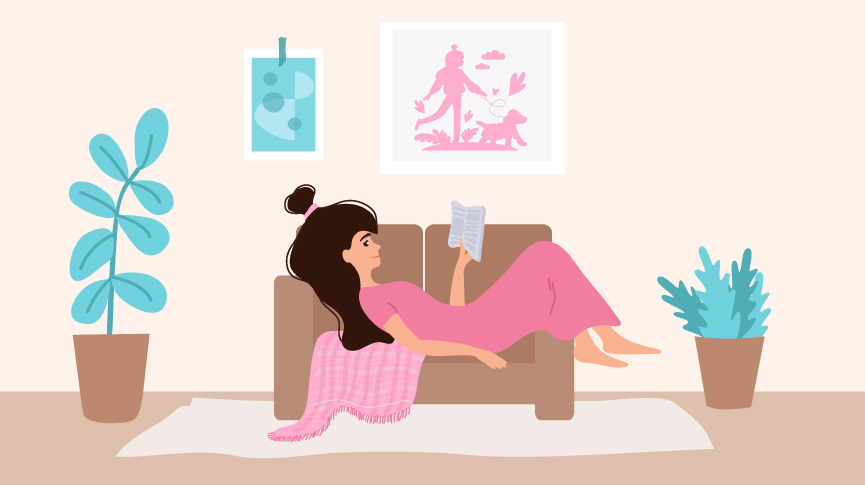Self-care tips for Premenstrual Dysphoric Disorder (PMDD)

If you’re reading this article, then we feel your pain. Whether you’ve already got a PMDD diagnosis or you’re still trying to get one, the PMDD struggle is all too real.
What is PMDD?
PMDD stands for premenstrual dysphoric disorder and it’s essentially a very severe form of PMS. In case you need a refresher, the most common symptoms of PMS are mood swings, tiredness, bloating, headaches, difficulty sleeping and tender breasts.
PMDD sufferers will experience these symptoms too but will experience some of them to such an extreme level that it interferes with their day-to-day life. These are more commonly reported symptoms of PMDD are:
- Feeling extremely upset or tearful
- Feelings of hopelessness
- Suicidal feelings
- Loss of interest in activities you normally enjoy
- Feeling extremely angry or irritable
- Feeling overwhelmed
- Increased sensitivity to rejection
- ‘Brain fog’
- Increased anxiety
- Feeling both mentally and physically drained
As well as the increased severity of the symptoms and the particular decline in mental health, another key difference between PMS and PMDD is when they happen. Whereas PMS commonly occurs roughly 5 days before menstruation, PMDD usually hits around ovulation, and its symptoms begin closer to 10 days before menstruation begins.
The trouble with PMDD
As well as the barrage of life-altering symptoms that can wipe out almost half of every month, PMDD sufferers have to battle with the difficulty of a widely misunderstood chronic illness. Many sufferers can spend years just trying to find a doctor who has even heard of PMDD.
Even once a diagnosis has been made, PMDD experts aren’t quite sure exactly what causes the condition, making it somewhat difficult to treat. Some researchers believe that sufferers are extremely sensitive to the changes in hormone levels in their bodies, but there is no one medical consensus on this.
Treatments for PMDD
Once you’ve managed to get a formal PMDD diagnosis from your doctor (and here are some tips on how to do that) they might recommend a number of different treatments for you, based on your individual case. These treatments could include:
- SSRIs (a kind of antidepressant)
- The pill
- CBT and counselling
- Temporary menopause
- Surgery to remove your uterus and or ovaries and fallopian tubes
These treatments range vastly in nature, and your doctor will be able to recommend the best course of action for you. You can read more about all these treatments here.
A few self-care tips for PMDD
Whether you’ve already been diagnosed and are receiving treatment from your doctor, or you’re still struggling to get that all-important diagnosis, here’s a run-down of a few of the most popular self-care treatments for PMDD.
Familiarise yourself with your cycle
If you don’t already use a period tracking app, it’s well worth trying one out. There is a wide variety out there, and many of them have free versions, like Clue and Flo. As well as recording the days where you’re menstruating, you can also enter your symptoms throughout the month. These apps can then predict when these symptoms are likely to occur and help you spot patterns. For example, many PMDD sufferers notice their mood begins to nosedive after ovulation, something that period tracking apps can help you spot in the future. When you can predict your off days, you can plan around them.
Try some supplements
There is, of course, no substitute for eating well and taking care of your body, but there is some evidence that certain dietary supplements can ease the symptoms of PMDD. In particular, Calcium, Magnesium, Vitamin E and Vitamin B6 have been shown to have some positive effects, find out more about this here.
Some people have also reported positive results when trying herbal supplements. Evening Primrose Oil, Gingko, Chasteberry and St John’s Wort are to name just a few. If you feel like supplements could help you, chat to your doctor or pharmacist about them for more info.
Talk it out
For an affliction like PMDD that can cause such crippling anxiety and depressive episodes, it’s really important that you have people in your life you can confide in about how you’re feeling and take a load off. They don’t say a problem shared is a problem halved is for nothing. It can be tricky talking to loved ones about PMDD, especially as most of them will likely be unaware of the condition and how negatively it affects your life. Make the effort to educate them and they’ll most likely want to help you out however they can. You can also seek the help of a professional therapist or a peer support group and you might want to consider telling your employer if you have one.
Be kind to your body & mind
PMMD is a cruel condition, both physically and mentally. To give yourself the best chance of winning the fight against it every month, try to keep yourself in good physical and mental condition. Make sure you’re getting regular exercise, even if it’s just a 30 minute walk a day. Also make sure you’re mindful of your mental health, and try to ward off stress as much as possible. You can also take advantage of simple ways to boost your mental health, like walks in nature, and practicing mindfulness.
However you choose to fight your own personal struggle with PMDD, just remember that you’re not alone, and help is always out then when you need it.

A collective group of “lady experts” at Intimina who love sharing our personal experiences, even when they are a little too personal. We believe it’s time to start breaking down the taboos around menstruation, motherhood, and menopause, and start owning our female health.


